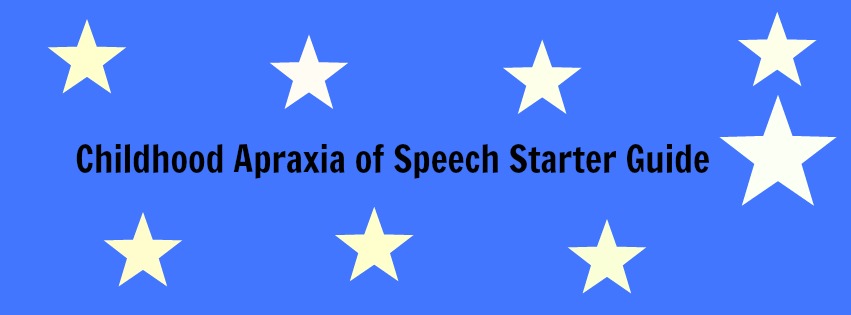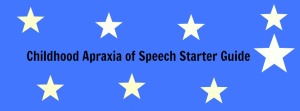What is Childhood Apraxia of Speech?
Definition and characteristics
Childhood Apraxia of Speech is a speech disorder that results from difficulty with programming, planning and sequencing the precise movements needed for clear speech.
The American Speech/Language Hearing Association (ASHA), denotes three main characteristics that must be present for a diagnosis of CAS.
- Inconsistent production on consonant and/or vowels in repeated productions of syllables and words.
- An example of the word doggy for my daughter who has apraxia ended up being produced doddy, do-yee, daddy, da-yee.
- Difficulty sequencing syllables and words of increasing complexity.
- The child might be able to say “dada,” but when words or added like “my dada” the child might say ‘da-da-da.’
- Errors with prosody
- Prosody can include syllable stress, and kids with CAS might stress the first syllable in each word: BAnana instead of baNAna or may give equal stress to every syllable BA-NA-NA.
- Can include difficulty with volume control. This was definitely true with my daughter. She could not be loud even when she tried in her younger toddler years.
- May have prolonged sounds and prolonged pauses, possibly giving the child ad staccato sound to their voice
Other soft signs that should be considered include:
Speech
- Vowel errors and/or reduced vowel inventory
- May have a tendency to reduce vowels to the schwa (uh). For example, buh-buh/bye bye.
- Groping
- The child’s mouth seems to make a lot of unnecessary movements while they “grope” for the correct placement
- Loss of words or sounds that were previously produced
- Consonant omissions in the initial position of words
- May be more successful with automatic versus volitional speech
- A child may say “mama” but then when asked to repeat “mah” may be unable to do so correctly
- Limited babbling as a baby, or limited sound variation in their babbling
- Typically comprehends much more than they can speak
Non-speech
- Oral apraxia (difficulty planning and executing non-speech oral motor movements
- May have trouble blowing raspberries, puckering, sucking out of straw or blowing out a candle
- General awkwardness or clumsiness
- Limb apraxia
- For more information on limb apraxia you can read posts from my guest occupational therapist blogger.
- Low muscle tone
- One sign of a weak core includes W sitting (see the inspired treehouse for information on this).
Who diagnoses Childhood Apraxia of Speech?
According to ASHA, a qualified Speech/Language Pathologist is the IDEAL professional to diagnose CAS. However, diagnosis can be tricky, so you want to make sure you find an SLP who has experience and/or specializes in CAS. Currently, CAS is both over-diagnosed and under-diagnosed, so don’t be afraid to ask questions to gauge your SLP’s experience and knowledge of it. A good SLP will not mind being asked questions about their experience with CAS or answering questions related to it.
The Childhood Apraxia of Speech Association of North America provides an advanced training for SLP’s who already have extensive experience in the disorder called the Childhood Apraxia of Speech Intensive Institute. You can read more about my boot-camp experience here:
What should therapy for CAS look like?
There are many programs out there that say they are geared toward the treatment of CAS. There is a growing body of evidence that the principles of motor learning affect the most change. In short, you should be seeing:
- frequent repetitions of target sounds or words (mass practice)
- feedback that is specific. The SLP should be giving them feedback such as “you’re lips were open, not closed,” rather than just “good job” “try again” or “that was great.”
- carefully chosen speech targets that take into account the child’s current phonetic repertoire and then practicing a variety of movement gestures (sound to sound, syllable to syllable, word to word) with these sounds.
- Cues – can be visual (SLP may pop her hand out for /p/) verbal (close your lips and use your humming sound), or tactile (SLP may use physical touch cues on the child like in PROMPT).
For a great description on what parents should look for in CAS treatment, see my interview the executive director and founder of apraxia-kids.org Sharon Gretz.
For a detailed description of DTTC, a therapy approach for apraxia, see my interview with Dr. Ruth Stoeckel from the Mayo Clinic.
For other reasons your child may not be speaking, read my article Apraxia? Phonological Disorder? Language Disorder? What’s the Difference?
A note about the school-age population
Since I have spent most of my 10 year career in the schools, I think it’s important to also address some symptoms SLP’s may see that vary slightly from toddler presentations.
By the time a child with CAS reaches Kindergarten, an SLP may run into three scenarios:
- The child who has almost resolved due to intense and appropriate early intervention
- The child who is still struggling significantly with motor planning, and is very unintelligible.
- The child is still essentially non-verbal
In scenario one, a child’s speech may be highly intelligible, with only residual articulation errors evident like a lisp, or an /r/ distortion of substitution. It’s important to review the file closely and see what prompted the initial diagnosis of CAS. This is important, because children may have additional issues after the CAS is resolved. With one particular 4th grader, his speech only contained persistent errors with three speech sounds; however, his sentence formulation, grammar and syntax remained very problematic. What is syntax? One element is to correctly sequence the words in a sentence. If a child had difficulty with the planning and sequencing of sounds, it ‘s not far off to think he/she may also have difficulty sequencing words correctly in a sentence. I treated him differently and used the principles of motor learning to guide his treatment, unlike my other kids with an expressive language delay that never had an apraxia diagnosis.
Other issues may include: pragmatics, narrative language, and persistent prosodic errors.
In scenario two, a child may be speaking but is highly unintelligible. By this age, they might actually have a vast repertoire of sounds, and actually be able to produce most sounds correctly in isolation. One year I had a five year old walk through my school door. One day he took out an alphabet BINGO and proceeded to name all the letters and letter sounds correctly in isolation. However, this kid could not string two sounds together or consistently.
In scenario three, the child may still be essentially nonverbal. Until the child can commit to a motor speech exam, meaning he can or will at least attempt to imitate a variety of sounds and movement gestures, a definitive diagnosis cannot yet be made. Aside from using Assistive Technology which can eventually facilitate speech, I would recommend starting with a functional core vocabulary book you two can make together that includes highly motivating syllables or words the child can work toward using sounds in his current repertoire. With one five year old I had, he could only produce bilabials (b,p,m) and and /n/. We started with word and word approximations to help him be more successful: i.e. 1. no 2. bah/ball 3. mah-mah/mama etc. Then we drilled them using the principles of motor learning that included massive amounts of repetition, involving visual and verbal cues, using specific feedback.
CAS is a complicated disorder that is many times over-diagnosed and under-diagnosed. In addition, the treatment approach varies from other traditional speech sound disorders.
For resources I recommend the apraxia-kids.org webiste. There is a wealth of information for parents and professionals.
To find CASANA certified SLP’s see the professional friends directory on the apraxia-kids webiste.
Laura Smith is a speech/language pathologist in the Denver Metro Area specializing in Childhood Apraxia of Speech. CASANA recognized for advanced training and expertise in Childhood Apraxia of Speech, she splits her time between the public schools and the private sector. She is dedicated to spreading CAS awareness. Her passion is fueled by all of her clients, but especially her own daughter who was diagnosed with Childhood Apraxia of Speech. For more information visit SLPMommyofApraxia.com


Hi,thanx for the wonderful information on childhood apraxia. I am a preschool teacher and have a little girl in my class who will be turning 3 next month. I am very concerned about her speech ability.. She does.not speek clear all the time and uses 2 word sentences most of the time. She is a very clever girl, knows and recognises fine detail and shapes , colours etc and points it out to me but struggles with speech. She is also a little bit clumsy with body movement at times. A few months back she had the fynny tendancy to go and lie in the dirt and lick the soil for long periods of time. She would also pick up strings or pieces
of material from clothes or the grpund and eat it. This has improved though in the past few months. Do you see any signs of abnormality here? Alsonto take into consideration is the fact that mommy and daddy speaks two different languages at home. She has improved slightly since I have only been speeking English wih her at school. Could this be a cause of delayed speech? I would like to speak to the parents but need an experts opinion first.
kind regards
Carike du Preez
(South Africa)
apraxia kids website
Pingback: A source of hope: Natalie's walk with apraxia - SLP Mommy of Apraxia